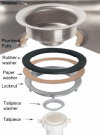Installing the drain connections to a kitchen sink are relatively easy and most homeowners with a few simple tools can save themselves some money by making these repairs. In this article you’ll see how to install a new basket strainer, continuous waste and trap.
Tools and materials you may require
- Pipe cutter
- Hacksaw
- ABS/PVC glue
- Large slip joint pliers
- Screwdriver
- Tape measure
- Torpedo level
- Teflon tape
- Plumbers putty
- Continuous waste kit
- P-trap with cleanout
- 1 1/2″ Pipe
- PO wrench
- 1 1/2″ trap adapter
- Basket strainers
Installing the basket strainers
-
 Place a small strip of plumbers putty all around the underside of the strainer then push it down through the hole in the sink.
Place a small strip of plumbers putty all around the underside of the strainer then push it down through the hole in the sink. - Under the sink you will have to place a rubber washer over the strainer’s threads then a paper washer under that.
- Hand tighten the locknut up against the paper washer.
- You may want someone to lend you a hand to tighten the locknut completely. Depending on the basket strainer you have, it can be held in place with a screwdriver or PO wrench, while you tighten the locknut.
- Install the tailpiece with the washer between the strainer and the tailpiece. If your using a brass or chrome tailpiece you should put some teflon tape around the threads of the basket strainer.
- Repeat for the opposite side.
Installing the drain and trap
- You can purchase a pre-manufactured connection for a kitchen sink called a continuous waste, but you can also hook up the drain using fittings and pieces of pipe cut to size.
-
 Assemble the continuous waste an connect it to the tailpieces of the sink. The tail pieces may need to be cut to size with a pipe cutter or a hacksaw if your careful.
Assemble the continuous waste an connect it to the tailpieces of the sink. The tail pieces may need to be cut to size with a pipe cutter or a hacksaw if your careful. - Some P-traps will come with adapters built in but if not, cut a small piece of pipe(about 2″) and fit the trap adapter to the top of it then dry fit in the top of the trap.
-
 Measure and cut a piece of pipe to go from the wall to the P-trap, dry fit all the pieces together and cut the continuous waste to the length required for a slight grade on the horizontal pipes.
Measure and cut a piece of pipe to go from the wall to the P-trap, dry fit all the pieces together and cut the continuous waste to the length required for a slight grade on the horizontal pipes. - When every thing lines up the it safe to glue and tighten the joints. Wipe off excess glue with an old rag or paper towel.
- Check for leaks by filling both sides of the sink and retighten any joints that leak.
